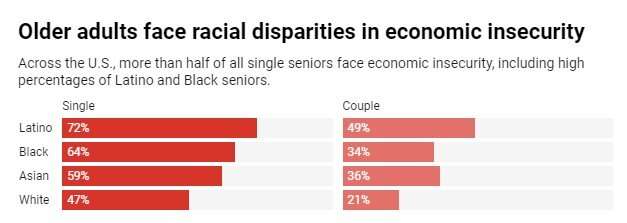
Older Americans who want to live independently face serious economic challenges. Half who live alone don’t have enough income to afford even a bare-bones budget in their home communities, and nearly 1 in 4 couples face the same problem.
Those numbers add up to at least 11 million older adults who are struggling to make ends meet, a new analysis shows.
The numbers are worse for older people of color. Dramatically higher percentages of Black, Latino and Asian older adults live on incomes that don’t meet their cost of living, even with Social Security. That can mean skipping needed health care, not having enough food, living in unhealthy conditions or having to move in with family.
These disparities often reflect lifelong disadvantages that add up as people of color encounter structural racism and discrimination that shape their ability to buy property and save for the future.
To calculate realistic rates of economic insecurity and estimate the disparities, my colleagues and I used the Elder Index, created by the University of Massachusetts Boston to measure the true cost of living for older adults. It tracks expenses for housing, health care, transportation, food and other basics, county by county. We paired the index with state-level income data to determine the percentage of people who don’t have enough income to cover their cost of living.
When we compared this information by race or ethnicity, wide disparities in economic security became apparent.
Disadvantages and stress add up
The disadvantages people of color face can extend through their lifetimes and can pass on to future generations.
Not having access to high-quality education and training programs that prepare young people for stable and well-paying careers, for example, can result in people of color having lower incomes and accumulating less wealth.
The median net worth of U.S. white families is nearly eight times greater than that of Black families, a gap due in part to whites receiving larger inheritances. Social Security benefits, which are based on the person’s earnings, are also lower on average for people of color, with the typical older Black or Latino family receiving annual benefits about 24% lower than what the typical non-Hispanic white family receives.
Black Americans are also less likely to own a home than their white counterparts, which can reduce their ability to build wealth.
Securing and protecting health into later life is also more challenging for many people of color. Exposure to unhealthy environments and poor access to health care result in health disparities that ripple throughout life.
Discrimination and bias in educational institutions, workplaces and health care settings, and throughout the community, can yield unfair outcomes and provoke health-damaging stress responses that persist for a lifetime. Moreover, a large number of older Latinos and Asians in the U.S. are immigrants. Although many have lived in the U.S. for decades, a sizable share arrived at an older age, and some may not have worked long enough in the U.S. to be eligible for Social Security benefits or safety-net programs that require citizenship.
These experiences accumulated over a lifetime can lead to starkly different levels of economic security for older adults based on race and ethnicity.

Where disparities run deepest
We found that the rates of elder economic insecurity among people of color also vary among states.
Among older Black singles, rates of economic insecurity ranged from 46% in West Virginia to 80% in Rhode Island. States with the greatest levels of elder economic insecurity tended to be in the Deep South or the Northeast, generally reflecting areas of particularly low income or high costs. But older Black singles experienced greater rates of economic insecurity than older white singles in every state we analyzed.
The geographic differences are complex.
Nationally, the disparity between Black and white economic insecurity for singles is 17 percentage points—64% of single Black seniors compared with 47% of single white seniors. But some states have far higher disparities.
For example, the economic insecurity difference between single Black and white seniors is 26 percentage points in both Mississippi and South Carolina, 29 in Rhode Island, and 39 in Washington, D.C. Between single Latino and white seniors, the disparity was 32 percentage points in both Texas and Massachusetts. The states with the highest disparities tend to have disproportionately high levels of economic insecurity among people of color, rather than unusually low levels of economic insecurity among their white counterparts.
These disparities didn’t just appear at later life but rather are structured by lifelong inequalities. More research will be required to fully understand the geographic patterns, but these inequalities are likely related to historical patterns of racism and to geographically distinct ways in which racial groups have become incorporated into local economies.
How to help struggling seniors
There are ways to help everyone build financial security for retirement. Investing in public education, ensuring fair access to well-paying and stable employment and promoting financial literacy about how to attain a secure retirement can help break the accumulation of disadvantage.
Today’s older adults who are struggling financially can’t go back, but there are several ways to help them now:
- Policies can promote affordable housing and affordable health care, which represent the biggest components of older Americans’ budgets.
- Governments can promote mechanisms that allow people to keep working into later life, which allows people to continue generating income and building wealth, and also delays drawing down other income sources such as pensions or Social Security benefits.
- Social Security and Medicare—the foundations of a secure retirement for millions of Americans—are essential for these groups. Older people of color rely more heavily than their white counterparts on Social Security and are at heightened risk when these programs are threatened.
- Making sure government assistance programs such as SNAP benefits for food and housing subsidies are accessible to the people who need them can also help. Ensuring access includes providing information in multiple languages and hiring outreach workers who understand the population’s needs.
Source: Read Full Article
